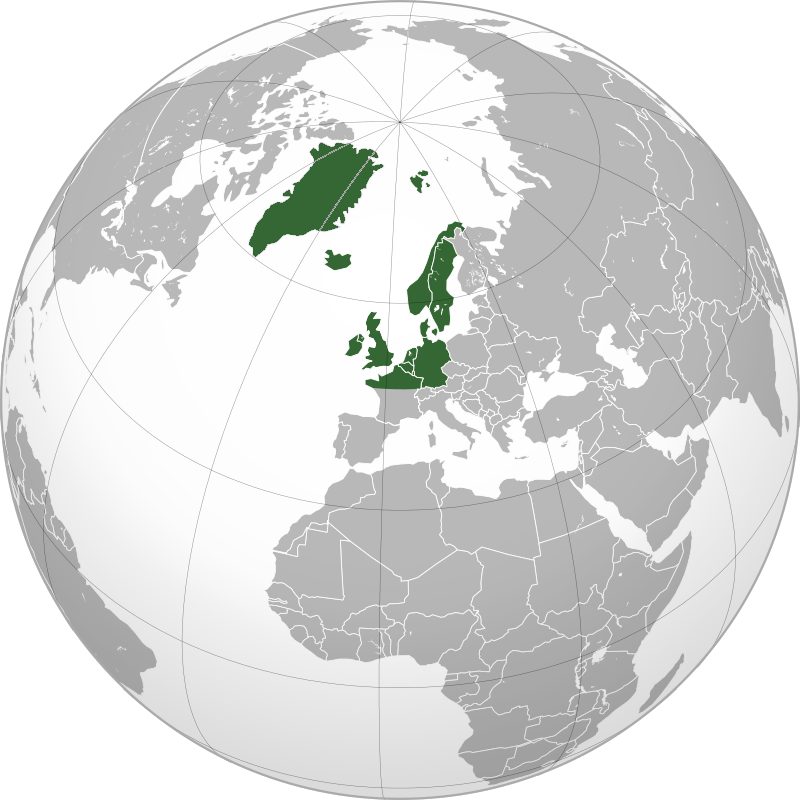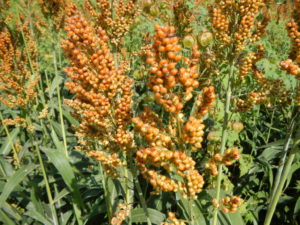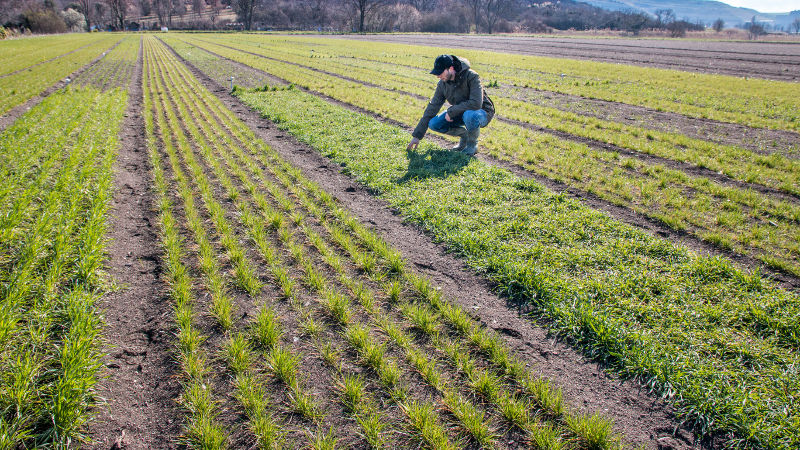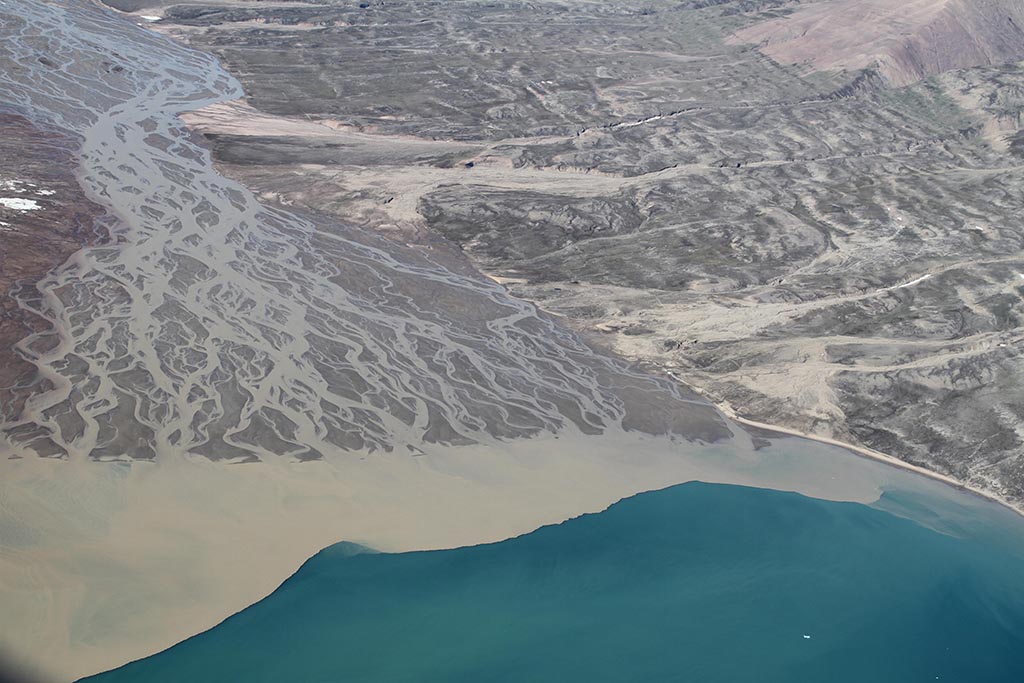Rock Dust as a Sustainable Amendment in Northwestern European Agriculture
Glacial deposit in Greenland
Introduction
The EU is the world’s leading exporter of agri-food, supplying 20% of world food and drink (Matthews, 2021; EEA, 2020). In 2020, more than 40% of Europe’s acreage was used for agriculture. 61% of this agricultural area was operated by high to medium intensity farms in terms of fertilizer and pesticide cost. The considerable growth in crop and livestock has caused environmental impacts that call for sustainable solutions.

There are several initiatives currently focused on sustainable agricultural practices in Northwestern Europe. The European Commission has announced several strategies under the guise of the European Green Deal geared towards general sustainability (von der Leyen, 2019), including the Farm to Fork and EU Biodiversity strategies, which aim to reduce use of chemical pesticides by half by 2030. The Integrated Nutrient Management Action Plan seeks to reduce nutrient loss by at least 50% and reduce use of fertilizers by at least 20% while securing soil fertility (Schilthuis, 2021).
This article investigates efforts in Northwestern Europe to achieve the European Commission’s goals with special attention to the attention of rock dust in nutrient management and reduction of fertilizer, albeit in experimental stages or on a larger scale. The pursuit of alternate mineral and nutrient sources has gained particular importance as a result of the 2022 Russian invasion of Ukraine, which has affected global mineral supply chains (GlobalData, 2022).
The role of rock dust in sustainable nutrient and pest management
A key element in many chemical fertilizers is phosphorus (P), due to its integral part in a crop plant’s primary functioning (Schaller et al., 2019). Commercial and affordable phosphorus reserves are expected to be depleted in 50 to 100 years (Gronholt-Pedersen, 2021). Although natural phosphorus in soils is relatively abundant, it is often bound to iron minerals or stabilized organic matter, and therefore not readily available for plant uptake. Schaller et al. (2019) of the University of Bayreuth demonstrated the efficiency of silicon to mobilize phosphorus in unaffected Arctic soils. It implied that silicon may be valuable to sustainably manage the availability of phosphorus in soils in general, when applied as silica or amorphous silicon structures (Knoll, 2019). As a result, the use of phosphorus fertilizers and the mining of phosphorus for fertilizer production could be scaled back.
Silica is currently applied as a vegan pest manager in German organic farming, which prohibits using pesticides (Fecke, 2016), capitalizing on silica’s proven effectiveness as a desiccant to combat undesirable insects and restore insect balance (US EPA, 1991).
In United Kingdom pig farming, a rock dust additive is applied to straw to absorb accumulated water and urine to form a solid, which in turn serves as nutrient-rich manure (Howell, 2021). Under the right conditions, this could also lead to a 20% decrease in ammonia (NH3) runoff, as opposed to so-called indoor deep straw systems (Howell, 2021). Another advent of nitrogen in agriculture is in nitrous oxide, a potent greenhouse gas that is the product of soil microbial activity in conversion of nitrogen-based fertilizer. Treating crop fields with basalt rock dust has shown to reduce nitrous oxide emissions (Ferber, 2022).
The role of rock dust to minimize use of conventional fertilizers

Glacial rock flour is another potentially sustainable amendment for the soil. About one billion tonnes of rock dust are deposited annually by glacial retreat in Greenland. This easily mineable material is nutrient-rich and enhances agricultural output due to the ready uptake of nutrients from the product’s predominantly micro-sized particles (Gronholt-Pedersen, 2021). This rock dust comes from glaciolacustrine deposits in Greenland, which consists of Archaean granite and gneiss. They are mainly composed of quartz, plagioclase and hornblende, in addition to biotite and K-feldspar (Sukstorf et al., 2020). Hamaker & Weaver (1982) highly recommended slow-weathering glacial gravel for remineralization and the agricultural importance of periglacial sediments has been widely demonstrated (i.e. Catt, 2011). Recently, scientists at multinational brewer Carlsberg demonstrated that an application of 25 tonnes of glacial rock dust per hectare on a barley field in Denmark increased crop yields by 30% (Gronholt-Pedersen, 2021). The glacial rock dust could replace phosphorus in fertilizer. However nitrogen (N) still needs to be added (Gronholt-Pedersen, 2021). In the next three years, large-scale field tests in Denmark, amongst others, will demonstrate the economic feasibility of distributing rock dust to farmers worldwide (Gronholt-Pedersen, 2021).
Researchers at the University of Sheffield have proven that adding relatively coarse-grained crushed basalt to UK clay-loam agricultural soils increased the yield of the cereal Sorghum bicolor – one of the most important crops for food and animal nutrition – by 20% without adverse effects (Armour, 2020; Kelland et al., 2020). Basalt contains at least six nutrients essential to plant growth, and has the added benefit of mitigating soil acidification. The latter is normally accomplished using agricultural limestone, the production of which causes significant agricultural emissions of greenhouse gas (Armour, 2020).
Basalt rock dust in carbon sequestration
Apart from improving crop yield while limiting conventional fertilizer usage, basalt rock dust could be employed to serve another goal: to sequester carbon dioxide. Kelland et al. (2020) also showed that application of basalt rock dust to soil samples increased its potential to store carbon dioxide (CO2) by four times.

These results support the outcome of prior research by Beerling et al. (2018), who modeled the impact of applying enhanced weathering in order to slow climate change by using basalt rock dust on croplands (see also Ferber (2022) and Armour (2020)). They found that enhanced weathering could sequester 2 billion tonnes of CO2 from the atmosphere per year by 2050; corresponding to the joint annual CO2 emissions of Germany and Japan (Ferber, 2022).
The main principle of enhanced weathering rests on generating aqueous chemical reactions between weathering silicate rocks and soluble CO2. These reactions yield base cations and primarily bicarbonate anions that – in turn – drain away from croplands. The process especially relies on the fast-weathering pyroxene in basalt to react with CO2. Beerling et al. (2018) envisions byproducts from the mining industry, such as stockpiled silicate rock dust, as a source. Commercial interest is evident through the funding of small field tests and new trials by the likes of The Future Forest Company based in Scotland.
Similarly, the German Carbon Drawdown Initiative and several experts from various academic fields planned a field project to support global carbon sequestration and mitigate climate change (Paessler, 2021). They argue that enhanced weathering meets the three major criteria of scalability, speed and permanence that are required for effective CO2 removal. The resulting “Project Carbdown” commenced in 2021 and bypasses the public funding process, increasing the frequency of experiments.
It must be noted that the Carbon Drawdown Initiative is focused on olivine, which Remineralize the Earth does not recommend for agriculture because the mineral profile of olivine may create a nutritional imbalance and nickel accumulation in soils and crops (Berge et al., 2012).
A year into the study, the Project Carbdown team reported measurable weathering effects. However, it was difficult to give exact measurements of weathering products due to the limited amount of rock dust used (Paessler, 2022). To that end, the team aims to use more rock dust in 2022 to develop reliable results. Moreover, the team will apply controlled irrigation as much as possible in order to optimize water supplies.
Conclusions
The considerable increase in the production of crops and livestock has caused environmental impacts that call for sustainable solutions, especially as commercial phosphorus reserves employed for chemical fertilizers are expected to be depleted in 50 to 100 years.
There are manifold current applications of rock dust in Northwestern European agriculture. Silicon in rock dust may be valuable to sustainably manage the availability of phosphorus in soil and for a vegan method of pest control. Other uses include managing nutrients, improving crop yield, limiting conventional fertilizer usage and sequestering CO2.

Niels Olfert is a M.S. geologist and writer employed as geotechnical engineer at Fugro in the Netherlands. Niels has produced multiple scientific written works, including his Master’s thesis and internship report, that received in-house publication. His preceding work focused on metamorphic and structural geology, and geophysics. His voluntary authorship at Remineralize the Earth mainly emphasizes his ongoing passion for science and zeal to succeed as a writer. Niels is also at present seeking to publish his debut novel.
References
- Armour, S. (2020, April 21). Rock dust helps soils store carbon and boosts crop yields, research shows. Institute for Sustainable Food, The University of Sheffield. https://www.sheffield.ac.uk/sustainable-food/news/rock-dust-helps-soils-store-carbon-and-boosts-crop-yields-research-shows.
- Armour, S. (2020, July 7). Applying rock dust to croplands could absorb up to 2 billion tonnes of CO2 from the atmosphere, research shows. Institute for Sustainable Food, The University of Sheffield. https://www.sheffield.ac.uk/energy/news/applying-rock-dust-croplands-could-absorb-2-billion-tonnes-co2-atmosphere-research-shows.
- Beerling, D. J., Leake, J. R., Long, S. P., Scholes, J. D., Ton, J., Nelson, P. N., … & Hansen, J. (2018). Farming with crops and rocks to address global climate, food and soil security. Nature plants, 4(3), 138-147.
- Ten Berge, H. F., Van der Meer, H. G., Steenhuizen, J. W., Goedhart, P. W., Knops, P., & Verhagen, J. (2012). Olivine weathering in soil, and its effects on growth and nutrient uptake in ryegrass (Lolium perenne L.): a pot experiment.
- Catt, J. A. (2001). The agricultural importance of loess. Earth-Science Reviews, 54(1-3), 213-229.
- Communication from the Commission to the European Parliament, the Council, the European Economic and Social Committee and the Committee of the Regions: A Farm to Fork Strategy for a fair, healthy and environmentally-friendly food system COM/2020/381 final (European Commission, 2020).
- Cordell, D., Drangert, J. O., & White, S. (2009). The story of phosphorus: global food security and food for thought. Global environmental change, 19(2), 292-305.
- Elser, J. J. (2012). Phosphorus: a limiting nutrient for humanity?. Current opinion in biotechnology, 23(6), 833-838.
- Elser, J. J., Bracken, M. E., Cleland, E. E., Gruner, D. S., Harpole, W. S., Hillebrand, H., … & Smith, J. E. (2007). Global analysis of nitrogen and phosphorus limitation of primary producers in freshwater, marine and terrestrial ecosystems. Ecology letters, 10(12), 1135-1142.
- European Environment Agency [EEA] (2020): Water and agriculture: towards sustainable solutions. EEA Report No 17/2020. Kopenhagen, 128 pp.
- Fecke, B. (2016, June 22). Pflanzenschutz mit Hacke und Kieselsäure. Deutschlandfunk. https://www.deutschlandfunk.de/oekolandwirtschaft-pflanzenschutz-mit-hacke-und-kieselsaeure-100.html.
- Ferber, D. (2022, January 10). Enhanced Rock Weathering. Anthropocene Magazine. https://www.anthropocenemagazine.org/2022/01/enhanced-rock-weathering/.
- GlobalData (2022, March 04). Russian invasion of Ukraine: Potential impact on supply chains of mineral commodities. Mining Technology. https://www.mining-technology.com/comment/supply-mineral-commodities/
- Gronholt-Pedersen, J. (2021, November 18). Climate-friendly farming: Greenland’s melting glaciers offer an answer. Reuters. https://www.reuters.com/business/environment/climate-friendly-farming-greenlands-melting-glaciers-offer-an-answer-2021-11-18/.
- Hamaker, J. D., & Weaver, D. A. (1982). Survival of Civilization. Seymour, MI, USA: Hamaker-Weaver Publishers.
- Howell, M. (2021, May 14). How can pig and poultry farmers meet consumers’ high expectations and remain productive? The Pig Site. https://www.thepigsite.com/news/2021/05/how-can-pig-and-poultry-farmers-meet-consumers-high-expectations-and-remain-productive.
- Kelland, M. E., Wade, P. W., Lewis, A. L., Taylor, L. L., Sarkar, B., Andrews, M. G., … & Beerling, D. J. (2020). Increased yield and CO2 sequestration potential with the C4 cereal Sorghum bicolor cultivated in basaltic rock dust‐amended agricultural soil. Global Change Biology, 26(6), 3658-3676.
- Knoll, C. (2019, June 2). Silizium könnte Phosphordünger über Jahre überflüssig machen. Deutschlandfunk. https://www.deutschlandfunk.de/landwirtschaft-silizium-koennte-phosphorduenger-ueber-jahre-100.html.
- Lewis, L. (2008). Scientists warn of lack of vital phosphorus as biofuels raise demand. The Times, 23.
- von der Leyen, Ursula (2019) ‘A Union that strives for more: My agenda for Europe’, Political Guidelines for the Next European Commission 2019-2024, available at https://ec.europa.eu/commission/sites/beta-political/files/political-guidelines-next-commission_en.pdf.
- Matthews, A. (2021, May 16). The EU’s position in global agri-food trade. Capreform. http://capreform.eu/the-eus-position-in-global-agri-food-trade/#:~:text=Based%20on%20this%20redefinition%20of,at%20best%20held%20their%20ground.
- Paessler, D. (2021, January 14). Introducing “Project Carbdown”: Our first “enhanced weathering” field trial aims to remove CO₂ from the atmosphere. Carbon Drawdown Initiative. https://www.carbon-drawdown.de/blog/2021-01-14-introducing-project-carbdown.
- Paessler, D. (2022, February 21). Project Carbdown: A Review of Year 1. Carbon Drawdown Initiative. https://www.carbon-drawdown.de/blog/2022-2-17-project-carbdown-a-review-of-year-1.
- Schaller, J., Faucherre, S., Joss, H., Obst, M., Goeckede, M., Planer-Friedrich, B., … & Elberling, B. (2019). Silicon increases the phosphorus availability of Arctic soils. Scientific reports, 9(1), 1-11.
- Schilthuis, G. (2021, September, 23). Perspectives for nutrient management in Europe Under the Farm to Fork Strategy and the Common Agricultural Policy [6]. Agriculture and Rural Development, European Commission.https://www.nweurope.eu/media/15027/phos4you_201_schilthuis_eu_com.pdf.
- Sukstorf, F. N., Bennike, O., & Elberling, B. (2020). Glacial rock flour as soil amendment in subarctic farming in South Greenland. Land, 9(6), 198.
- United States Environmental Protection Agency (1991, September). R.E.D. FACTS Silicon Dioxide and Silica Gel. https://www3.epa.gov/pesticides/chem_search/reg_actions/reregistration/fs_G-74_1-Sep-91.pdf.
Support us on Patreon
Thank you for joining us today! Please become a member of RTE and support us on Patreon. Unlike many larger organizations, we work with a team of determined and passionate volunteers to get our message out. We aim to continue to increase the awareness of remineralization to initiate projects across the globe that remineralize soils, grow nutrient dense food, regenerate our forests’ and stabilize the climate – with your help! If you can, please support us on a monthly basis from just $2, rest assured that you are making a big impact every single month in support of our mission. Thank you!








José Cabello
July 11, 2022 (11:19 am)
Excellent initiative .
Would you like to do something equivalent in Chile ?